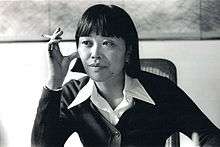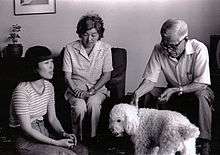Wendy Yoshimura
| Wendy Yoshimura | |
|---|---|
 | |
| Born |
Wendy Masako Yoshimura January 17, 1943 Manzanar Internment Camp, California |
| Occupation | Painter |
| Movement | Symbionese Liberation Army |

Wendy Masako Yoshimura (born January 17, 1943) is an American still life watercolor painter better known for her involvement with the Symbionese Liberation Army. She was born in a World War II-era California internment camp, and raised in Japan and California's Central Valley. She encountered and became involved in radical politics during her last year of art college as a result of meeting Willie Brandt, founder of the Revolutionary Army in Berkeley, California.
Early life
Yoshimura was born at the Manzanar Internment Camp for Japanese Americans where her American-born parents were incarcerated. After the war the Yoshimura family moved to Etajima, a small island off the coast of Hiroshima, where her father worked for the Allied Occupation forces. The family returned to the US when Yoshimura was 13 years old. Because she did not speak English, Yoshimura was initially placed in the second grade in the Fresno school system. She graduated from the California College of Arts and Crafts (now California College of the Arts) in 1969.[1]
Revolutionary Army
Yoshimura became associated with the Revolutionary Army, a group founded by her then boyfriend, Willie Brandt, who appended the title to public statements claiming responsibility for violent actions intended to express opposition to the Vietnam War. In 1972, police discovered a weapons and explosives cache in a Berkeley garage she had rented and described it as a "massive bomb factory."[2] They also found letters taking credit for planned future bombings targeting the University of California, Berkeley campus including the Naval Architecture building, and notes describing a specific plan to kidnap or assassinate World Bank President and former defense secretary Robert McNamara at his winter residence in Aspen, Colorado.[2] Brandt and two others were arrested in Berkeley on March 31, 1972 and subsequently convicted, but Yoshimura evaded a police dragnet and fled California.[2][3] She lived under an alias in New Jersey until 1974.
Symbionese Liberation Army
Also in 1974, the two surviving original members of the Berkeley terrorist group Symbionese Liberation Army (Bill Harris, Emily Harris), with kidnapping victim-turned fugative Patty Hearst, relocated to rural Pennsylvania after six of their comrades died in a shootout with Los Angeles police. Sports writer and political activist Jack Scott, who had helped the high-profile fugitives make their way east, arranged for Yoshimura to join them and handle shopping and other public transactions.
After two months with the group, Yoshimura left and returned alone to California, taking up residence in San Francisco. Hearst and the Harrises found their own way back into the state and regrouped in Sacramento, California. When the FBI found Yoshimura's thumbprint in the SLA's rural hideout, newspaper headlines tied her to the group and she fled San Francisco and reunited with them in Sacramento.
In Sacramento, with associates from the San Francisco Bay Area, some of the fugitives planned and carried out a bank robbery in which a customer was shot and killed. Hearst's account in Every Secret Thing states that she and Yoshimura opposed the action and were therefore assigned to "switch cars" far from the scene. After the robbery the group abandoned Sacramento and fled separately to San Francisco.
Arrest and conviction
On September 18, 1975, Yoshimura was arrested with Hearst in a second-floor apartment at 625 Morse Street by FBI Special Agent Tom Padden and San Francisco Police Department Inspector Tim Casey.[3][4][5] Padden and Casey, failing to read Hearst and Yoshimura their Miranda rights, did not obtain a warrant until twenty-six hours later; thus weapons evidence including a handgun in Yoshimura's purse and a shotgun in the bedroom was suppressed.[3] During her trial, Japanese Americans who empathized with her family's experience during World War II gave $150,000 to aid her legal defense through the Wendy Yoshimura Fair Trial Committee.[6]
Grand jury investigation
In 1991 Yoshimura was granted limited immunity to testify during a grand jury investigation into the fatal 1975 bank robbery, which killed Myrna Opsahl, 42-year-old mother of four.[7] One SLA member, Michael Bortin, had pleaded guilty for the robbery itself. No indictments resulted at the time. In 2002 five former SLA members and associates were arrested and four of them pleaded guilty to charges related to that crime.

Present day
Yoshimura is currently an artist residing in north Oakland, California. She teaches water color painting at her studio and at a San Francisco community center.[8] Her still-life watercolors are often displayed in the Bay Area.[9][10][11][12]
In media
- American Woman is a fictionalization of Yoshimura's story by Susan Choi that was a finalist for the Pulitzer Prize.
- Wendy... Uh... What's Her Name is a documentary by Curtis Choy

References
- ↑ Wendy Yoshimura (1943 - ). AskArt.com.
- 1 2 3 "Guerrilla: The Taking of Patty Hearst". Public Broadcasting Service.
- 1 2 3 '70s Radical Bombing Case Court motion. CourtTV.com.
- ↑ Yoshimura's arrest at 37°43′14″N 122°26′26″W / 37.720423°N 122.440653°W
- ↑ "Patti's Twisted Journey". Time. September 29, 1975.
- ↑ Alexander, Shana. Anyone's Daughter. Viking Press. p. 101. ISBN 0-670-12949-6.
- ↑ "Symbionese Liberation Army members, then and now". Associated Press. May 11, 2004.
- ↑ Cultural Arts & Crafts Programs. JCCCNC.org.
- ↑ 0506.indd Mission Arts Monthly. June and July 2005.
- ↑ Spicer, Jakki K. In the Galleries June 13-20, 2007. EastBayExpress.com. June 13, 2007.
- ↑ Han, Sarah. "Art Listings". San Francisco Bay Guardian. Retrieved 2008-02-15.
- ↑ New Works by Yoshimura on Display in Open Studio. Hokubeinews.com.
